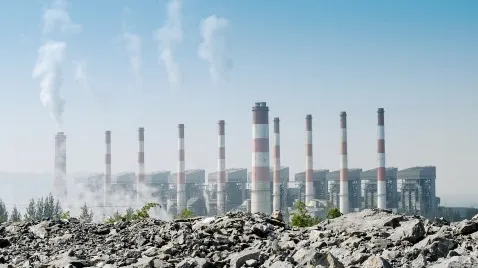
Asia faces financial risks with energy transition
Fossil fuel exit is still a steep climb as Asian markets need to rely on coal power at least in the short run for energy security.
Asia’s rising power consumption drives it to continue reliance on fossil fuels in the short term, challenging the region’s decarbonisation plans. This becomes an even steeper climb as Asian markets run the risk of incurring financial losses with moves to retire high-emitting power plants ahead of their lifespan.
Asia is projected to see the highest growth in power consumption in the next decade, Ashis Kumar Pradhan, senior coal analyst at Rystad Energy, told Asian Power. He noted that to meet this demand, the region is expected to depend largely on coal for electricity generation.
“To achieve their carbon neutrality goals by 2050-2070, many Asian nations plan to rely on fossil fuels in the short term. However, the long-term focus is shifting towards increasing the use of renewable energy sources with the support of battery storage and pumped hydro systems.”
Asian nations have taken concrete steps to get rid of dirty energy with renewable energy targets coupled with coal phase-out and divestment plans; but coal’s dominance remains. This is mainly linked to its affordability and reliability as a baseload power to support renewable energy (RE) sources.
Pradhan noted the region continued relying on coal during the pandemic with coal prices notably declining, compared to volatile gas prices.
“The current energy system is heavily optimised for the use of fossil fuel. Decarbonising the energy system will require countries to accept losses in these stranded fossil infrastructures before their planned retirement,” Dr. Ken Tay, senior regional energy transition analyst at Rystad Energy, said.
Coal in Asia
It did not help that Russia’s invasion of Ukraine drove prices of liquefied natural gas (LNG) to new heights, leading Asian markets to view gas as an “expensive and unreliable fuel source,” Warda Ajaz, project manager for Asia Gas Tracker at Global Energy Monitor, said.
Pakistan, for instance, announced it will increase domestic power capacity, including coal, as it plans to phase out imported LNG.
China and India are amongst the economies actively promoting power generation, Pradhan noted. Rystad Energy data showed that in 2022, a total of 106 gigawatts (GW) of coal-fired power plants were approved by the Chinese government. Of this, around 50 GW were already under construction in 2022, whilst 56 GW are set to begin construction in 2023.
Likewise, India has introduced its National Electricity Policy which provides a target of 50 GW coal-fired power generation in the next decade. Rystad noted 25 GW of this was already in construction with plans to add the remaining 25 GW in the pipeline.
Meanwhile, Japan and South Korea have neither set plans to actively phase out coal nor construct new plants in the near term; whereas Indonesia and Vietnam, which account for 65% of the coal-fired capacity in the region combined, have entered the Just Energy Transition Partnership (JETP) to take a step out of coal.
Rystad Energy noted that as of 2022, Indonesia’s coal fleet reached 40 GW. With the JETP, the country committed to suspending nearly 14 GW of on-grid coal-fired power and decommissioning existing plants before its planned lifecycle ends.
For its part, Vietnam pledged to add only up to 6GWs of coal capacity in the future.
Sreejeet Barik, junior analyst for power and coal at Rystad Energy, noted Vietnam remained committed to this target as its recently launched Power Development Plan 8 showed it only has approximately a 6.125-GW coal capacity under construction.
“It is worth noting that the agreement made by Indonesia primarily targeted on-grid power plants and did not encompass captive power plants used by industries such as nickel, aluminum, steel, and chemical plants,” Barik said, noting that Indonesia has more than 12 GW of captive coal-fired capacity in the pipeline, including in the nickel industry.
On top of this, Indonesia hosts a relatively young fleet of coal-fired power plants with around 80% of them aged less than 20 years old. This could translate into “significant financial implications” particularly for the Indonesian government which owns many of the plants through the state-owned enterprise PLN.
Coal exit is similarly difficult for Vietnam as it faces a downturn in power supply, prompting it to rely more on coal. This also comes as disruptions in the supply of gas-for-power undermine the government’s plan to depend on gas.
Gas expansion
Gas was considered a transitional fuel as it was believed to emit fewer carbon than coal, leading to countries adopting gas for their energy transition. Ajaz noted that countries in East and Southeast Asia are poised to see “explosive growth” in gas-fired power plant development as they seek cleaner alternatives.
In particular, more than 60% of gas-fired capacity development globally is found in Asia. Over half of which are in East and Southeast Asia.
“The proposed gas expansion will be detrimental to climate goals, as any new fossil-based projects are ‘incompatible’ with a target to limit planetary warming to 1.5°C,” Ajaz said.
She added that if these units become operational, more than 750 million tonnes of carbon emissions are expected annually. This would nearly double the current annual emissions of gas-fired power plants in Asia which is roughly 1.3 billion tonnes.
“Asia is already witnessing the catastrophic impacts of climate change in the form of floods, severe heat waves and other extreme weather events,” she said, citing data from the World Meteorological Organisation that found Asia facing more than 100 natural hazards in 2021.
Of this, 80% were flooding and storms, leading to the death of around 4,000 individuals, affecting nearly 50 million and costing economies a total of US$35.6b.
Moreover, Ajaz said importing LNG fuel could also pose risks for Asia’s energy security as in Bangladesh and Pakistan which struggled to afford high LNG prices. LNG prices soared ten-fold in mid-2020, leading Bangladesh to implement rolling blackouts that could potentially last up until 2026.
“Domestically produced, renewable power can alleviate these issues and set Asian nations on a path of energy independence,” she said. “Renewable energy technologies like onshore wind and solar projects present a wiser investment choice, as they now cost, on average, 40% less than new coal or gas plants.”
Transition ‘not fast enough’
Ajaz observed that whilst significant strides have been taken to rid power mixes of coal, the transition away from existing and planned fossil fuel projects is still not moving “fast enough.”
“Even though the past year has underscored the risks — especially in Asia — of relying on natural gas imports, the region ranks highest in the world for prospective gas power plant buildout,” she added.
Not only that, GEM found that even as financial institutions are implementing coal divestment policies, coal could still source funding from other financial pipes.
“For the era of coal to come to an end, all these pipes must be closed. Financial institutions have the capacity, the power, and the incentive to put the world on course to meet our global climate and public health goals by ending the flow of capital that has sustained the era of coal for too long,” Ajaz said.
“Until then, energy planning that promotes new coal plants or props up existing coal plants presents a risk and delays the much-needed transition to cleaner energy sources,” she added.
Grid infrastructures will also need to be upgraded to handle the increased load coming from existing renewable energy sources, which would require massive investments. Ajaz flagged that the lack of development in grid systems has made investments in renewables seem to be less attractive.
Additionally, governments and financial institutions should further look into equitable funding for the transition, similar to the JETP in Indonesia and Vietnam. This is particularly important as renewables deployment remains economically nonviable in some Asian markets.
“Renewables are not yet economically viable in many Asian countries. So, switching to renewables in current conditions might mean an increase in tariffs. The cost of switching to renewables is also a significant issue,” she said.
“Transitioning away from fossil fuels, especially in the short run, will also come with a financial loss in terms of stranded assets, as the existing infrastructure might end up being abandoned,” she added, citing the case of the Philippines which recently saw its first LNG terminal commissioned.
On top of this, “strong and clear” long-term government policies will also be needed for the transition. Dr. Tay recommended a carrot-and-stick approach through subsidies for renewable investment as well as a carbon tax on emissions. Phase-outs will also need to cover both direct and indirect subsidies on fossil fuels towards this end.



















 Advertise
Advertise






